Other common names:
- Ladysthumb: lady’s thumb, smartweed, persicary, spotted smartweed, heartweed, spotted knotweed, red shanks, willow weed, lovers pride, ladythumb, heart’s ease
- Pennsylvania smartweed: pinkweed, purple head, glandular persicary, heart’s ease, swamp persicary, smartweed
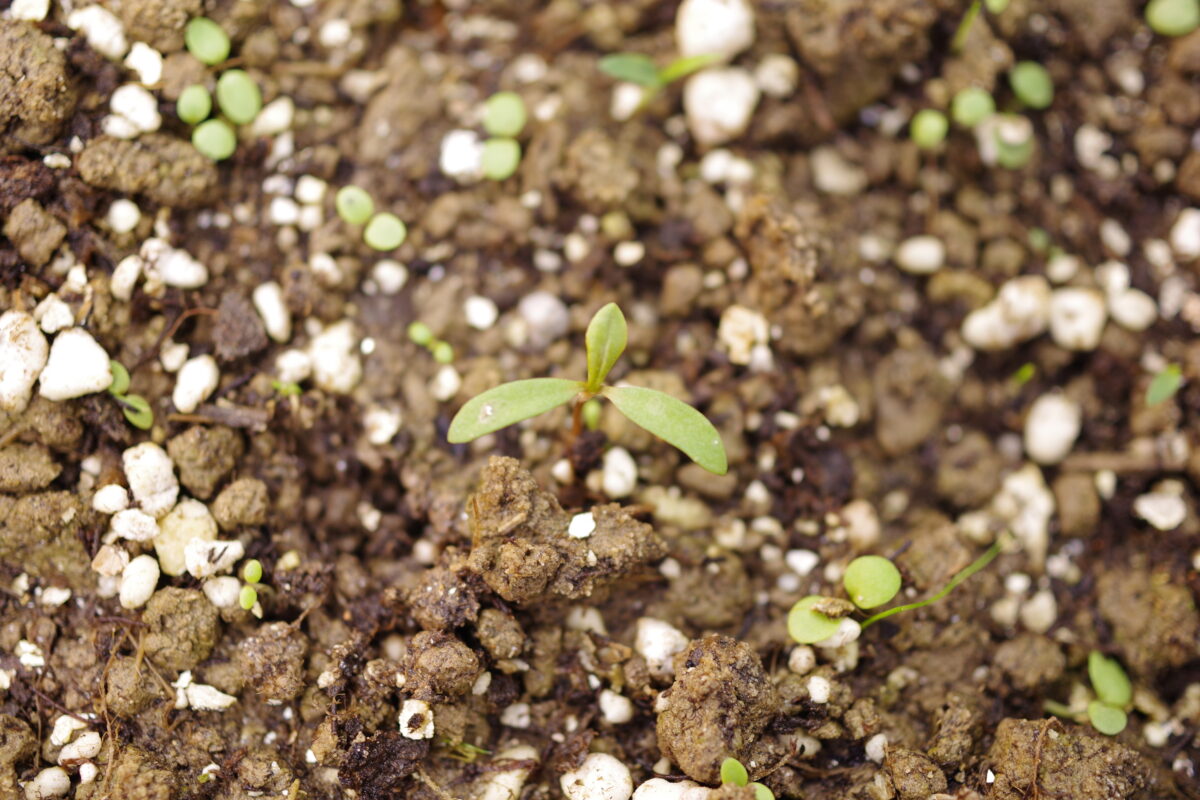
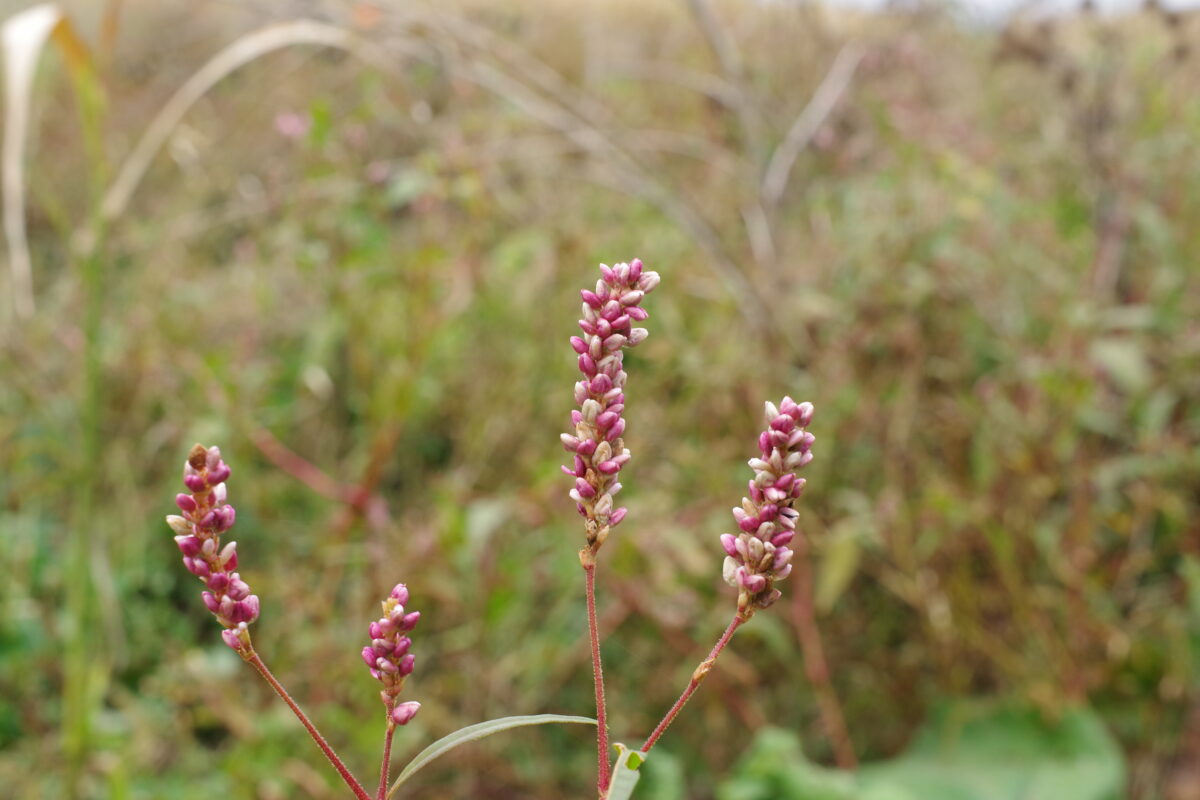
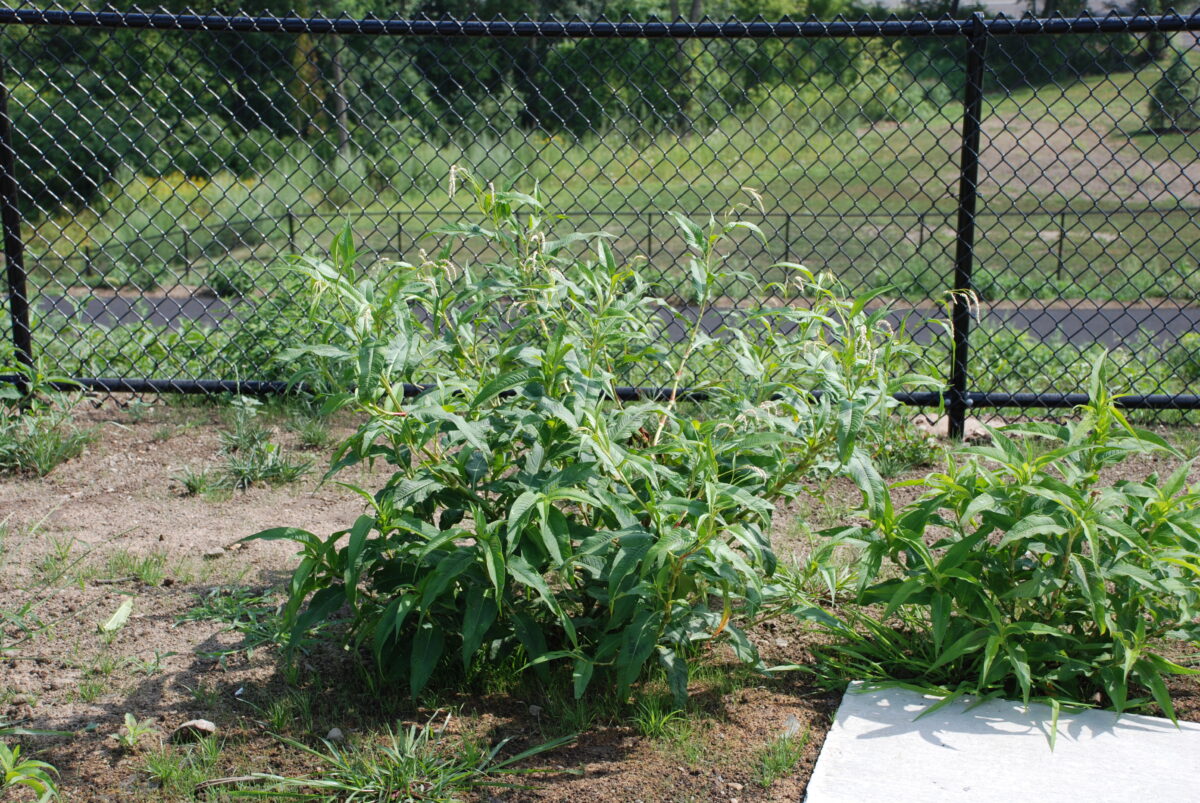
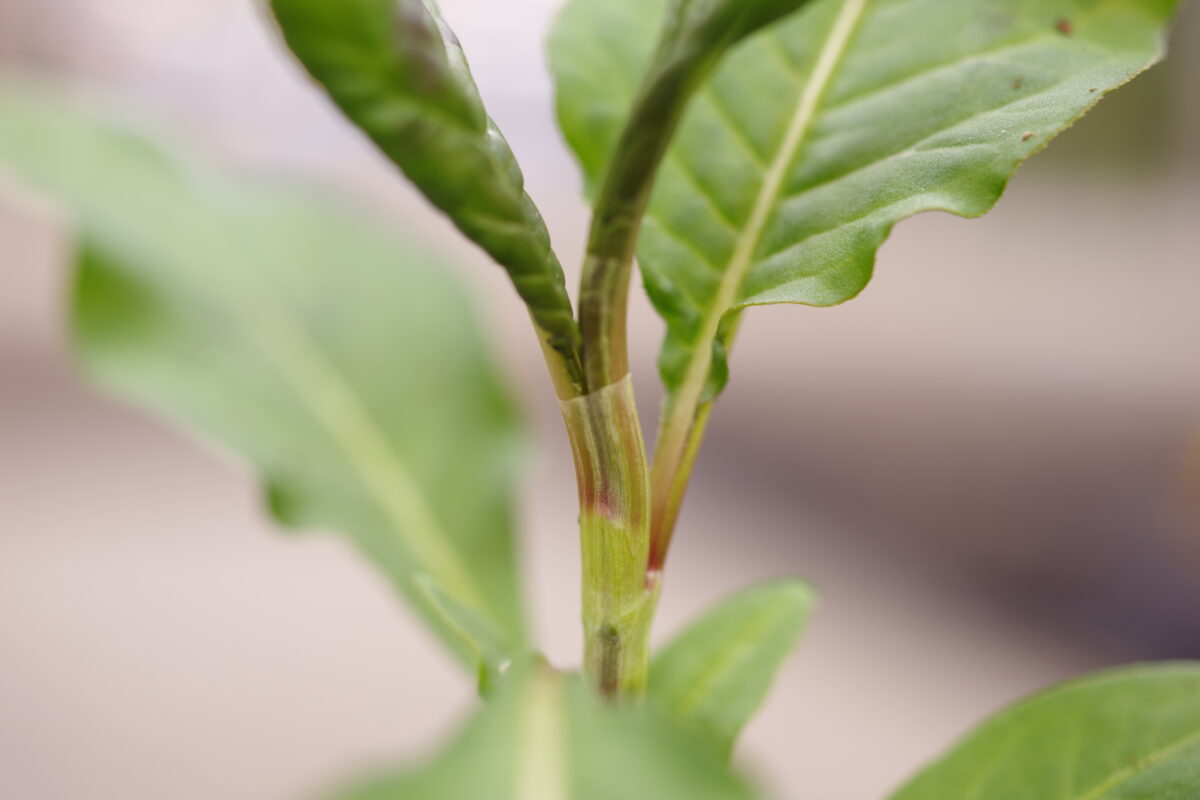
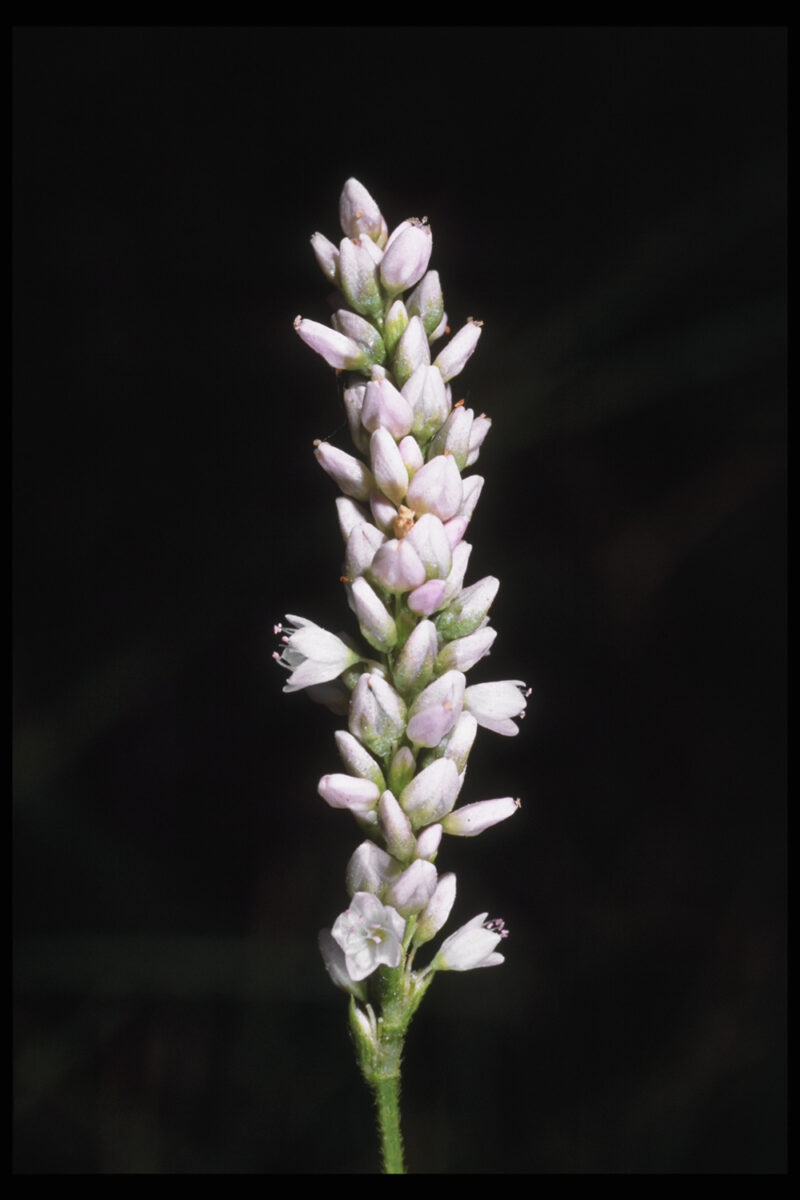
Ladysthumb, Polygonum persicaria L. = Persicaria maculosa Gray
Pennsylvania smartweed, Polygonum pensylvanicum L.
= Persicaria pensylvanica (L.) Small
Identification of Smartweeds
Family: Buckwheat family, Polygonaceae
Habit: Upright or sprawling, branched summer annual herbs
Description: Seedlings have hairy edged cotyledons. The first true leaves are lanceolate to ellipse shaped and hairy on the upper surfaces and edges. Seedling stems can be erect or prostrate. Leaf-stem junctions are swollen and covered with transparent, papery membranes (ocreae) that extend up and around the stem.
- Ladysthumb: Cotyledons are round tipped, lanceolate and 0.13–0.5 inch long by 0.13–0.3 inch wide. Seedling stems are brown or pink to bright red. Young leaves are lightly hairy on their upper surfaces and pale green, with a black spot sometimes present on the leaf surface. Stems are sometimes lightly hairy, otherwise they are similar to Pennsylvania smartweed stems.
- Pennsylvania smartweed: Cotyledons are ellipse to lanceolate and 0.13–1 inch long by 0.13–0.5 inch wide. Seedling stems are pink at the base. Young leaves are hairless, with purple-hued undersides. The hairless, red-purple stems change angle at lower nodes, giving the young plant a zig-zag shape.
Mature plants have green to red, leaning or upright, freely branching stems. Leaf-stem junctions are swollen and covered by an ocrea. Leaves are alternate, smooth to lightly hairy, lanceolate to elliptical and often have a black or purple spot in the center of the blade surface. Roots are fibrous from a small taproot.
- Ladysthumb: Stems are 1–3 feet tall. Leaves are 1.25–6 inches long by 0.2–0.7 inch wide and sometimes covered in short, flat hairs; they lack the long stalks of Pennsylvania smartweed. The darkened spot is often present on the blade surface. Ocreae have a row of 0.06 inch-long bristly hairs at the top.
- Pennsylvania smartweed: Flat, stiff hairs are present on the 1–4 foot-tall stem. The stalked leaves are 2–6 inches long by 1.25 inch wide and hairless to sparsely hairy. The darkened spot is inconsistently present and is often only a subtly different shade of green. Ocreae are hairless.
Flowers are small, white to red and clustered at stalk ends.
- Ladysthumb: Flowers are pink to red-purple and rarely white. Clusters are 1 inch long.
- Pennsylvania smartweed: Flower stalks are hairy and occasionally sticky. Flowers are pale to bright pink or white. Clusters are 1.5 inches long.
Fruits and seeds: Seeds are flat, shiny, black, pointy tipped and round to oval shaped.
- Ladysthumb: Seeds are 0.1 inch wide and occasionally three sided.
- Pennsylvania smartweed: Seeds are 0.13 inch wide.
Similar species: Tufted knotweed [Polygonum cespitosum Blume var. longisetum (Bruijn) A.N. Steward] ocreae also have bristles, but the bristles are longer, over 0.25 inch, and the plant is shorter, less than 1 foot. Pale smartweed (Polygonum lapathifolium L.) has hairless ocreae; spotless, purplish-green, 2–6 inch-long leaves; 3 inch-long nodding flower clusters; and brown seeds.
Management of Smartweeds
Crop rotation is an important component in managing Pennsylvania smartweed and ladysthumb. Since nearly all the emergence of these species occurs by late spring, tillage before a summer planted crop like tomatoes or a late planting of soybeans will largely eliminate these species for that year. A winter grain crop will be competitive against these weeds when they emerge in spring. High crop sowing density and close row spacing (4 inches) can suppress ladysthumb in spring wheat, and these tactics are probably helpful in any cereal grain. These species die out of the seed bank at an intermediate rate, and consequently grains following alfalfa were found to have 27–29% as many smartweeds as grains following grains. These species can, however, establish in later years of a forage crop, and the hay must therefore be mowed before seed set.
Tine weed spring grains and row crops pre- and post-emergence to kill seedlings. Since seedlings commonly emerge from up to 2 inches, tine weeding will be more effective than rotary hoeing, though a well-timed rotary hoeing will kill part of the population. If weed density is high, tine weed winter grains in the spring as seedlings emerge. Since the seedlings do not become tall quickly, throwing 2 inches or more of soil into the crop row can effectively bury most seedlings that escape tine weeding in row crops.
Organic and synthetic mulches can effectively suppress these weeds. These species are likely to respond to fertility amendments at least as much as the crop, so avoid over fertilization.
Ecology of Smartweeds
Origin and distribution: Ladysthumb is a native of Eurasia, where it occurs from western Europe eastward through central Russia, and the Middle East to northern India and southward across North Africa. It also occurs in Japan and has been introduced into Australia, New Zealand and North and South America. In North America, it occurs throughout the contiguous United States and southern Canada, and northward into the Yukon and Alaska. Pennsylvania smartweed is native to eastern North America. It occurs in most areas from the Atlantic to the prairie states and provinces but is more sporadic in the intermountain states and far west.
Seed weight: ladysthumb, 1.4–4 mg; Pennsylvania smartweed, 3.6–6.8 mg.
Dormancy and germination: The seeds of both species are dormant when shed from the parent plant and require several months of after-ripening before they will germinate. A few weeks of cold, wet conditions break dormancy. Once dormancy has been broken, ladysthumb germinates better at 86°F than at 50°F or 68°F, and temperature fluctuations of at least 14°F greatly increase germination. Similarly, non-dormant seeds of Pennsylvania smartweed germinate best in warm, fluctuating temperatures, for example, 86/59°F or 95/68°F. However, exposure to temperatures over 59°F under conditions unfavorable for germination reinduces dormancy of ladysthumb, and drying also has been reported to induce secondary dormancy. As both species show greatly reduced emergence during summer, induction of secondary dormancy by warm, dry soil conditions probably occurs in Pennsylvania smartweed also. Nitrate stimulates germination of ladysthumb, but the effect is weak and only acts on relatively new seeds. Germination of Pennsylvania smartweed was greater than that of several other common annual weeds under wet conditions but lower under dry conditions.
Seed longevity: In experiments in annually tilled soil, ladysthumb seeds declined at a rate of 20% and 28% per year, but, in a similar experiment, seeds declined at 37% per year. In several five-year experiments in which the top 3 inches of soil was stirred three times per year, seeds of ladysthumb declined by an average of 38–43% per year. In another experiment, the number of seedlings emerging in an annually tilled soil declined 38% per year. However, some seeds of ladysthumb can survive in the soil for 20 years if left undisturbed. Pennsylvania smartweed and ladysthumb seeds can survive up to 30 years of burial. Pennsylvania smartweed seeds buried in late October had 40–63% viability 10 months later. In an Alaskan study, undisturbed seeds declined by an average of 25% per year, and, after burial for 19.7 years, 3.3% of seeds were still viable.
Season of emergence: Both species tend to emerge in early to mid-spring, with some emergence continuing into late spring for Pennsylvania smartweed and early summer for ladysthumb.
Emergence depth: Ladysthumb seedlings emerge best from the top 1.6 inch of soil, but a few seedlings can emerge from as deep as 2.4 inches. Pennsylvania smartweed emerges readily from anywhere in the top 2 inches of soil and a few seedlings can emerge from 4 inches.
Photosynthetic pathway: C3
Sensitivity to frost: Neither species tolerates temperatures below 32°F. A 27°F frost killed about half the leaves on Pennsylvania smartweed.
Drought tolerance: Ladysthumb tolerates a range of soil moisture, from drought (daily wilting) to continuous flooding. Flexibility in energy allocated to roots and in photosynthesis versus water loss via transpiration explain the adaptive responses of this species to moisture conditions. Pennsylvania smartweed does best in moist but well drained habitats and is more tolerant of overly wet than dry conditions. It maximizes biomass production under saturated soil conditions but maximizes seed production under field capacity conditions. Photosynthesis of Pennsylvania smartweed declines more rapidly than velvetleaf or giant foxtail with increasing drought stress, probably because it closes stomates and maintains a higher plant water potential than the other species.
Mycorrhiza: Mycorrhiza have been reported in some samples of ladysthumb and absent in others.
Response to fertility: Ladysthumb is moderately to highly responsive to fertility, with substantial differences among populations. Plant size increased roughly three- to 10-fold when balanced N-P-K fertility increased from very low to high rates. Excessively high fertility neither helped nor harmed the plants. Moderate fertilization of an agricultural field with 15-30-15 fertilizer increased growth of Pennsylvania smartweed by 43%. The equivalent of 50 pounds per acre each of N, P and K added to a low fertility potting mix increased growth about three-fold, but higher fertility rates did not cause additional growth. Thus, Pennsylvania smartweed appears to be less responsive to fertility than many crops. Pennsylvania smartweed and ladysthumb tolerate a wide range of pH, from 4–8.5.
Soil physical requirements: Pennsylvania smartweed occurs on fine to course textured soils, and ladysthumb is found on a wide variety of soils including muddy riverbanks, silty alluvium, heavy clay, sand, black muck, peat, cinders and manure heaps. Both species are moderately well adapted to anaerobic conditions and commonly occur in wetlands.
Response to shade: Pennsylvania smartweed and ladysthumb are generally considered shade intolerant. Ladysthumb growth and seed production was decreased by shade, however, this species adapts to shade by reducing leaf thickness and by allocating more tissue to leaves. Pennsylvania smartweed growth is significantly reduced by shade, and maximum photosynthesis is only reached in full sunlight.
Sensitivity to disturbance: Ladysthumb tolerates wheel traffic and trampling by livestock. It becomes dwarfed if clipped repeatedly in the vegetative state. If clipped when flowering, it may overwinter in areas with a mild winter. Stem cuttings are capable of regenerating into plants.
Time from emergence to reproduction: Pennsylvania smartweed and ladysthumb begin flowering at six to nine weeks after emergence, and plants can have mature seeds by July. Both species continue producing seeds until fall.
Pollination: Ladysthumb is primarily self pollinated but some cross-pollination by insects probably also occurs. Pennsylvania smartweed is pollinated by insects, including ants, but pollen transfer within a plant can fertilize flowers.
Reproduction: When growing with relatively little competition, ladysthumb typically produces 200–800 seeds per plant, but large plants may produce 1,200–4,500 seeds. In a spring wheat crop, however, plants produced 40–150 seeds per plant, depending on row spacing and seeding rate of the crop. When grown as a monoculture in North Carolina, Pennsylvania smartweed produced 93,000–119,000 seeds per plant, whereas when grown with cotton, it produced 19,000–22,000 seeds per plant. A dense population of Pennsylvania smartweed growing with giant foxtail and common ragweed produced an average of 60 seeds per plant.
Dispersal: Seeds of both species pass through grazing animals intact and thus disperse when animals are moved and when manure is spread. Cottontail rabbits eat both species, but only the smaller seeds of ladysthumb pass through the rabbits unharmed. Seeds of ladysthumb have reportedly been moved in mud on the feet of gulls. In the 1940s, ladysthumb was a common contaminant of forage legume and grass seed, with red clover being particularly prone to contamination. Poorly cleaned forage and cover crop seed probably continues to be a mode of dispersal today. Pennsylvania smartweed is found in irrigation water. Ladysthumb seeds float and are dispersed in irrigation water. As both species are commonly found along the edges of streams and rivers, seeds are likely deposited in lowland fields during flood events.
Common natural enemies: Birds and cottontail rabbits eat seeds of both species. The widespread specialist aphid Capitophorus hippophaes infested an experimental population of Pennsylvania smartweed in Illinois but had little influence on growth and reproduction. Pennsylvania smartweed seeds frequently carry pathogenic fungi that damage or kill young plants.
Palatability: Ladysthumb and Pennsylvania smartweed have low forage quality and palatability for grazing animals, although Pennsylvania smartweed was as palatable to sheep as oats. Pennsylvania smartweed is a valued species in wetlands because of its abundant seed production and superior nutritional quality for supporting migratory birds and other wildlife.
Summary Table of Smartweed Characteristics
| Smartweed, ladysthumb Smartweed, Pennsylvania | ||||||||
|---|---|---|---|---|---|---|---|---|
| Growth habit | Seed weight (mg) | Seed dormancy at shedding | Factors breaking dormancy | Optimum temperature for germination (F) | Seed mortality in untilled soil (%/year) | Seed mortality in tilled soil (%/year) | Typical emergence season | Optimum emergence depth (inches) |
| short, branched | 1.4–4 3.6–6.8 | Yes | cms, at | 86/59 to 95/68 | 25–50 | 24–43 | early to mid-spring | 0–2 |
| Photosynthesis type | Frost tolerance | Drought tolerance | Mycorrhiza | Response to nutrients | Emergence to flowering (weeks) | Flowering to viable seed (weeks) | Pollination | Typical & high seed production (seeds per plant) |
| C3 | low | moderate low | unclear | moderate | 6–9 | 4 | both | 100 & 2,000 20,000 & 100,000 |
Table Key
General: The designation “–” signifies that data is not available or the category is not applicable.
Growth habit: A two-word description; the first word indicates relative height (tall, medium, short, prostrate) and second word indicates degree of branching (erect, branching, vining).
Seed weight: Range of reported values in units of “mg per seed.”
Seed dormancy at shedding: “Yes” if most seeds are dormant when shed, “Variable” if dormancy is highly variable, “No” if most seeds are not dormant.
Factors breaking dormancy: The principle factors that are reported to break dormancy and facilitate germination. The order of listing does not imply order of importance. Abbreviations are:
scd = seed coat deterioration
cms = a period subjected to cold, moist soil conditions
wst = warm soil temperatures
li = light
at = alternating day-night temperatures
ni = nitrates
Optimum temperature range for germination: Temperature (Fahrenheit) range that provides for optimum germination of non-dormant seeds. Germination at lower percentages can occur outside of this range. The dash refers to temperature range, and the slash refers to alternating day/night temperature amplitudes.
Seed mortality in untilled soil: Range of mortality estimates (percentage of seed mortality in one year) for buried seeds in untilled soil. Values were chosen where possible for seeds placed at depths below the emergence depth for the species and left undisturbed until assessment. Mortality primarily represents seed deterioration in soil.
Seed mortality in tilled soil: Range of mortality estimates (percentage of seed mortality in one year) for seeds in tilled soil. Values were chosen for seeds placed within the tillage depth and subjected to at least annual tillage events. Seed losses are the result of dormancy-breaking cues induced by tillage, germination and deterioration of un-germinated seeds.
Typical emergence season: Time of year when most emergence occurs in the typical regions of occurrence for each weed. Some emergence may occur outside of this range.
Optimum emergence depth: Soil depths (in inches below the soil surface) from which most seedlings emerge. Lower rates of emergence usually will occur at depths just above or just below this range.
Photosynthesis type: Codes “C3” or “C4” refer to the metabolic pathway for fixing carbon dioxide during photosynthesis. Generally, C3 plants function better in cooler seasons or environments and C4 plants function better in warmer seasons or environments.
Frost tolerance: Relative tolerance of plants to freezing temperatures (high, moderate, low).
Drought tolerance: Relative tolerance of plants to drought (high, moderate, low).
Mycorrhiza: Presence of mycorrhizal fungi. “Yes” if present; “no” if documented not to be present, “unclear” if there are reports of both presence and absence; “variable” if the weed can function either with or without, depending on the soil environment.
Response to nutrients: Relative plant growth response to the nutrient content of soil, primarily N, P, K (high, moderate, low).
Emergence to flowering: Length of time (weeks) after emergence for plants to begin flowering given typical emergence in the region of occurrence. For species emerging in fall, “emergence to flowering” means time from resumption of growth in spring to first flowering.
Flowering to viable seed: Length of time (weeks) after flowering for seeds to become viable.
Pollination: “Self” refers to species that exclusively self-pollinate, “cross” refers to species that exclusively cross-pollinate, “self, can cross” refer to species that primarily self-pollinate, but also cross-pollinate at a low rate, and “both” refers to species that both self-pollinate and cross-pollinate at relatively similar rates.
Typical and high seed production potential: The first value is seed production (seeds per plant) under typical conditions with crop and weed competition. The second value, high seed production, refers to conditions of low density without crop competition. Numbers are rounded off to a magnitude that is representative of often highly variable reported values.
Further Reading
Lee, H.S., A.R. Zangerl, K. Garbutt and F.A. Bazzaz. 1986. Within and between species variation in response to environmental gradients in Polygonum pensylvanicum and Polygonum virginianum. Oecologia (Berlin) 68: 606–610.
Mertens, S.K. and J.H. Jansen. 2002. Weed seed production, crop planting pattern, and mechanical weeding in wheat. Weed Science 50: 748–756.
Sultan, S.E. and F.A. Bazzaz. 1993a. Phenotypic plasticity in Polygonum persicaria. I. Diversity and uniformity in genotypic norms of reaction to light. Evolution 47: 1009–1031.

